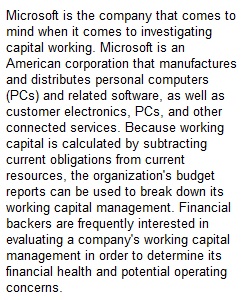


Q Overview Working capital management is critical to an organization’s ability to meet its short-term obligations. When proposing new projects or investment ideas for corporations, it is critical to consider working capital red flags such as excess credit use by the business or a low cash balance. Managing such issues early on can help corporations acquire a competitive advantage in the marketplace. Prompt Using the business you selected for Project Two, complete the calculations for determining working capital, and describe their relevance in assessing financial health. Specifically, you must address the following rubric criteria: • Financial Statement(s): Explain the various financial statement(s) needed to calculate a business’s working capital and how each financial statement is used. Provide examples to support your claims. • Working Capital’s Role: Discuss how effective working capital management supports a healthy business. • Working Capital Interpretation: Use the appropriate formula to calculate working capital, then discuss the business’s current financial liquidity position. o For example, does the business have sufficient working capital on hand to address bills to suppliers? Will there be potential cash inflow at the end of the year? • Working Capital Management Direction: Discuss the current direction of the business regarding working capital management. o Keep in mind that financial statements reflect a specific moment or period of time and the value of the business’s working capital during that period. To get a better understanding of the direction in which a business is going, use the business’s balance sheets from Mergent Online to compare the business’s value today against its value from one year ago. Guidelines for Submission Your submission should be a 2 to 3-page Word document with 12-point Times New Roman font, double spacing, and one-inch margins. Any sources should be cited according to APA style. Module Five Activity Rubric Criteria Proficient (100%) Needs Improvement (70%) Not Complete (0%) Value Financial Statement Explains the various financial statement(s) needed to calculate a business’s working capital and how each statement is used Shows progress toward proficiency, but with errors or omissions; areas for improvement may include explaining in more detail the various financial statement(s) needed to calculate a business’s working capital and how each statement is used Does not attempt criterion 15 Working Capital’s Role Discusses how effective working capital management supports a healthy business Shows progress toward proficiency, but with errors or omissions; areas for improvement may include discussing in more detail how effective working capital management supports a healthy business Does not attempt criterion 20 Working Capital Interpretation Uses the appropriate formula to calculate working capital and discusses the business’s current financial liquidity position Shows progress toward proficiency, but with errors or omissions; areas for improvement may include discussing in more detail the business’s current financial liquidity position or using the appropriate formula to calculate the working capital Does not attempt criterion 20 Working Capital Management Direction Discusses the current direction of the business regarding working capital management Shows progress toward proficiency, but with errors or omissions; areas for improvement may include discussing in more detail the current direction of the business regarding working capital management Does not attempt criterion 25 Articulation of Response Clearly conveys meaning with correct grammar, sentence structure, and spelling, demonstrating an understanding of audience and purpose Shows progress toward proficiency, but with errors in grammar, sentence structure, and spelling, negatively impacting readability Submission has critical errors in grammar, sentence structure, and spelling, preventing understanding of ideas 20 Total: 100%
View Related Questions